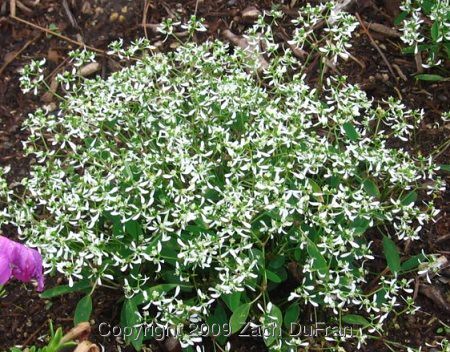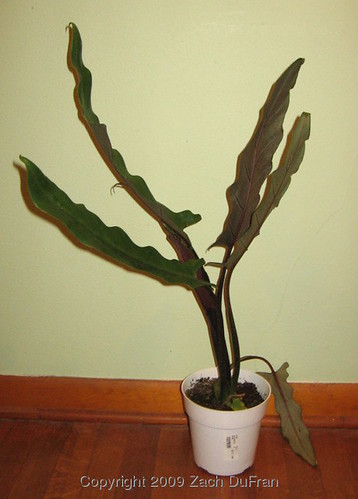Have you ever found yourself telling someone about a
new plant that you saw recently?
There's three kinds of "new" plants in my book:
- a hybrid plant which was cultivated by humans and is just introduced on the market,
- a naturally occurring species that has just been discovered in the wild,
- a plant that has been around for ages but has just come back into style.
I suppose there should be a fourth category - a new naturally occurring species or hybrid - but I won't get into that.
We're probably all familiar with plants in
the first category. Everyday there are new hybrids being produced. In fact, there are
millions of new hybrids being produced. But only a small fraction of those experiments prove to be successful and make it to the market. Most of the efforts are concentrated on already popular plants whose market could be widened if certain traits of the plants were improved. The "improvements" can range from cold hardiness to heat tolerance, drought tolerance to flood tolerance, a number of different light preferences, a variety of variegations, and even the structure of the growth. Some plants that come to mind would be the vast array of colors that are available in the popular flowering plants - roses, daylilies, tulips, Clematis, etc. Other common hybrids are in grasses and trees - the foundations of most domestic landscapes. A new hybrid that I had to buy this year is the Euphorbia 'Diamond Frost.' It's a beautiful plant for a mixed container, or all by itself. And it is very heat tolerant. I might have to try to keep some of mine alive indoors over the winter, since it is only hardy in the warmest USDA zones (10+).
 |
| Euphorbia 'Diamond Frost' - a newish hybrid that is a very popular annual container plant |
The second category - newly discovered naturally occurring species - is an interesting category. Today there is little area on the planet that hasn't been precisely mapped and cataloged. On the other hand, there are many remote locations which are just beginning to take note of their particular endemic species (plants that only grow in that one unique location). New species are being discovered fairly often. One day that discovery process will probably grind to a halt, but we're not there yet! I am on the International Aroid Society's mailing list and it is very exciting to receive emails from some of the leading scientists in the world who are conducting research in the field and reporting back to the Aroid community about new species and whatnot. (By the way, you don't have to be a member of the IAS to be on the mailing list.)
Coincidentally, after having written most of this post, but before publishing to my blog, I ran across a news story about research in the eastern Himalayas which has uncovered 353 new species of plant and animal life. The news story was focused on the animals, but I found that 242 of the 353 new species were plants (including Orchids, Poppies, Palm trees, Bamboos, Ferns, Clematis and Impatiens). If you want to read more, here's the
news story and here's the
actual report.
I happened upon another plant recently that caught my eye. The plant was being sold as a ground cover at Lowe's, but I would have happily bought it as a tropical house plant. The plant had very slender, dark green leaves along long, trailing stems that creep along the ground. The midvein of each leaf was vibrant white or silver and with some subtle silver veins reaching out to the tips. The plant was labeled Euonymous 'Wolong Ghost.' I immediately thought of the Wolong Nature Preserve in China. This is the area that was hit harshly by the earthquakes last year and is one of the few places where the Giant Pandas are still roaming in the wild. After doing a little research online, I found out that this plant was named as such because it was collected in the Wolong Nature Preserve and brought back to the US for propagation! I also read in the one review on Dave's Garden that this plant makes a lousy ground cover because of its growth rate. That was fine by me, since I wanted to keep it in a pot. It's beauty probably wouldn't be appreciated as a ground cover anyway. I bought 2 of the little plants the next day and put them in a pot, which now sits on my desk at work (and receives lots of compliments).
 |
| Euonymous fortunei 'Wolong Ghost' selected by growers at Hersonswood - image courtesy Oregon State University |
The third category is a very interesting one. I think about it from time to time. It recently came to mind when I was reading Ken Druse's
Planthropology. It may be hard to admit, but mankind's fondness for different plants is just as susceptible to fads and trends as clothes are. Bell bottoms were reinvented and re-marketed recently with the boot bottom jeans; simple tulips are coming back into favor after decades of more frilly, elaborate roses. It's all part of the human factor.
We don't find favor in plants solely because they are useful to us or because one plant serves a better purpose than another. While there is no objective measure of beauty that I know of, we wouldn't even use it if we found one. Some plants are grown solely because of their hideousness (which you could also argue is in the eye of the beholder - or wincer).
And the definition of beauty is always changing. At one time, heavier people were considered more beautiful because it meant that they were wealthy and did little work themselves. There are plants coming in to fashion today that have been neglected for years or some that have never been considered beautiful in a landscape setting before. One example would be the use of native grasses and weedy-looking wildflowers. While people have probably enjoyed the beauty of these plants in nature before, they were reluctant to dig them up and replant them in an organized flowerbed until recently.
One interesting fad is that plants are beginning to be appreciated for their hardiness and native attributes. As our culture is increasingly more aware of conserving energy and water, gardeners are acknowledging that plants which grow well naturally in their area are probably the best ones to plant in their garden. They will be better attuned to the local annual rainfall and light amounts and require less water from a hose.
Horticulturalists have been capitalizing on the trend of cold hardy and drought tolerant plants by making new hybrids with more vibrant colors than the naturally occurring species. (
Here is an article, if you're interested.) But those plants really belong in my first category, not this one.
You could even say that some garden trends follow the economy closely. I haven't done a study myself, but I would bet that the ratio of perennials to annuals purchased each year would correlate pretty well with the overall health of the national economy. When you have less money to spend, you're unlikely to spend it on plants that will only be around for a season.
Gardening itself is really an art form. And just like other forms of art, there are always new styles being invented and old styles being rediscovered and appreciated.
















